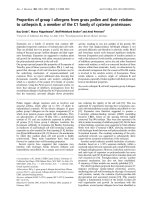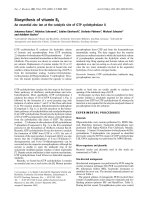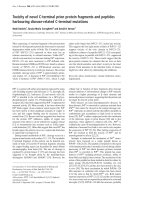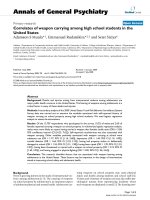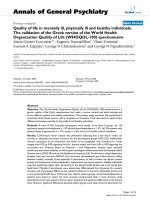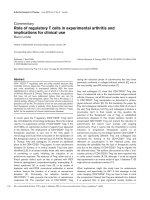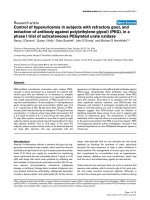Báo cáo y học: " Success of organ donation after out-of-hospital cardiac death and the barriers to its acceptance" docx
Bạn đang xem bản rút gọn của tài liệu. Xem và tải ngay bản đầy đủ của tài liệu tại đây (43.75 KB, 2 trang )
Available online />Page 1 of 2
(page number not for citation purposes)
Abstract
It is well documented that transplants save lives and improve
quality of life for patients suffering from kidney, liver, and heart
failure. Uncontrolled donation after cardiac death (UDCD) is an
effective and ethical alternative to existing efforts towards
increasing the available pool of organs. However, people who die
from an out-of-hospital cardiac arrest are currently being denied
the opportunity to be organ donors except in those few locations
where out-of-hospital UDCD programs are active, such as in Paris,
Madrid, and Barcelona. Societies have the medical and moral
obligation to develop UDCD programs.
It is well documented that transplants save lives and improve
quality of life for patients suffering from kidney, liver, and heart
failure. But in many countries, moral courage and public
health policies have not kept pace with need. In a recent
issue of Critical Care, Fieux and colleagues [1] demonstrate
remarkable results obtained through a coordinated effort to
obtain viable kidneys from people who suffer out-of-hospital
cardiac arrest in Paris.
In the US, over 100,000 people are currently awaiting organs
and some 28,000 transplants are performed annually.
However, lack of organs results in 8,000 patients who die or
become too sick to receive a transplant every year. Further-
more, recent trends suggest the number of patients awaiting
organs is increasing by several thousand yearly. Similar
experience is documented worldwide [2].
In 2006, the US Institute of Medicine (IOM) suggested that
the transplantation community pursue donations from non-
heart beating donors in the out-of-hospital setting (that is,
uncontrolled donations after cardiac death (UDCD)) to meet
the demand for solid organs [3]. At the time, such conclu-
sions were based on case series experience from the US [4]
and Spain [5,6] demonstrating that this pool of potential
kidney donors yielded transplantation outcomes similar to
that of donation after neurological determination of death
(DNDD) and controlled donations after cardiac death
(CDCD). Although Fieux and colleagues [1] report high rates
of delayed graft function compared to the Madrid UDCD
program [5], it is encouraging that, even using cold perfusion
techniques, they achieved similar excellent rates for graft
survival.
The current strategies of CDCD and living donation have
practical and ethical limitations. Using donors where care is
withdrawn in a hospital setting (that is, CDCD) has raised
issues about how the time and manner of death will be
determined and whether the patient is actually ‘dead’ [7].
Living donation raises its own set of concerns: the closer the
donor is to the recipient, the more concerns emerge about
coercion; the more distant the donor, the more worries about
commodification. As the recent scandal about illegally
purchased organs in the US illustrates [8], need dictates
action; illegal, mercenary, or altruistic. Furthermore, neither of
these approaches has generated the numbers of organs
needed. Current CDCD strategies still yield less than 1,000
organs annually in the US, and the number of living donor
kidneys has been steadily declining since 2004 [2]. It is clear
that present strategies cannot meet the need.
Commentary
Success of organ donation after out-of-hospital cardiac death
and the barriers to its acceptance
Bradley J Kaufman
1
, Stephen P Wall
2
, Alexander J Gilbert
3
, Nancy N Dubler
4
and Lewis R Goldfrank
2
;
for the New York City Uncontrolled Donation after Cardiac Death Study Group
1
Fire Department of the City of New York, Brooklyn, NY 11201, USA
2
Department of Emergency Medicine, Bellevue Hospital Center and NYU School of Medicine, New York, NY 10016, USA
3
Division of Nephrology, New York University School of Medicine, New York, NY 10016, USA
4
Montefiore-Einstein Center For Bioethics, Montefiore Medical Center, Albert Einstein College of Medicine, Bronx, NY 10467, USA
Corresponding author: Bradley J Kaufman,
Published: 5 October 2009 Critical Care 2009, 13:189 (doi:10.1186/cc8047)
This article is online at />© 2009 BioMed Central Ltd
See related research by Fieux et al., />CDCD = controlled donations after cardiac death; DNDD = donation after neurological determination of death; IOM = US Institute of Medicine;
UDCD = uncontrolled donations after cardiac death.
Critical Care Vol 13 No 5 Kaufman et al.
Page 2 of 2
(page number not for citation purposes)
UDCD programs avoid the dangers of live donation and
evade the controversy that surrounds CDCD. UDCD
respects the ‘dead-donor rule’ and complies with the deep
medical traditions of respecting life at all costs and respect-
ing the body after death. During resuscitation, Emergency
Medical Service rescuers must focus completely on their task
of restarting the heart to achieve the return of spontaneous
circulation in a patient in cardiac arrest. Fortunately, tech-
niques for resuscitation have advanced and survival after out-
of-hospital cardiac arrest has improved greatly in the past
years (New York City Fire Department, unpublished data).
When survival is no longer a possibility, and the decision to
terminate resuscitative efforts is made independently of organ
donation considerations, the ethics clearly allow for the
pursuit of UDCD.
If it is evident that UDCD is an effective and ethical alternative
to existing efforts (that is, living donations, CDCD, and
DNDD), why has UDCD not been more widely accepted? In
order for organs to remain viable, interventions for organ
preservation must be initiated within minutes after pronounce-
ment of death. It may be difficult to obtain necessary consent
for these interventions from grieving family members. To
address this challenge, countries such as France and Spain
have passed legislation allowing ‘presumed consent’ for
preservation. Therefore, preservation measures may be
initiated unless the patient has specifically ‘opted-out’. This
works well within a society comfortable with the notion of
presumed consent. Other societies should consider first-
person consent for organ donation (as may be indicated
through organ donor consent registries or on donor cards
such as drivers’ licenses). The latter approach is that
advocated for the US in the recent work by DuBois [9] and
the New York City UDCD Study Group [10].
Currently, people who die from an out-of-hospital cardiac
arrest are denied the opportunity to be organ donors except
in those few locations where out-of-hospital UDCD programs
are active. The results reported by Fieux and colleagues in
this journal, and the continuing success of the Madrid and
Barcelona out-of-hospital UDCD programs, demonstrate the
viability and reproducibility of such protocols. The IOM
conservatively estimated that in the US about 22,000
decedents could become UDCD donors [3]. It is conceivable
that widespread dissemination of UDCD could obviate the
waiting list for kidney transplants [11]. Thus, societies have
the medical and moral obligation to develop UDCD
programs.
Competing interests
The authors declare that they have no competing interests.
Acknowledgments
The NYC UDCD Study Group is composed of the following: New York
City Health and Hospitals Corporation, New York Organ Donor
Network, New York University School of Medicine, and the Fire Depart-
ment of the City of New York. It is supported by the US Health
Resources and Services Administration (HRSA) grant # R380T08761.
The opinions expressed in this publication are solely those of the
authors with Lewis Goldfrank, MD, responsible for its content. These
opinions are not reflective of afore mentioned institutions or HRSA as
the funder.
References
1. Fieux F, Losser MR, Bourgeois E, Bonnet F, Marie O, Gaudez F,
Abboud I, Donay JL, Roussin F, Mourey F, Adnet F, Jacob L:
Kidney retrieval after sudden out of hospital refractory cardiac
arrest: a cohort of uncontrolled non heart beating donors. Crit
Care 2009, 13:R141.
2. Human Resources and Services Administration (HRSA)
Organ Procurement and Transplantation Network (OPTN)
data []
3. IOM: Organ Donation: Opportunities for Action. Washington, DC:
National Academies Press; 2006.
4. Kowalski AE, Light JA, Ritchie WO, Sasaki TM, Callender CO,
Gage F: A new approach for increasing the organ supply. Clin
Transplant 1996, 10:653-657.
5. Fondevila C, Hessheimer AJ, Ruiz A, Calatayud D, Ferrer J,
Charco R, Fuster J, Navasa M, Rimola A, Taura P, Gines P,
Manyalich M, Garcia-Valdecasas JC: Liver transplant using
donors after unexpected cardiac death: novel presentation
protocol and acceptance criteria. Am J Transplant 2007, 7:
1849-1855.
6. Sánchez-Fructuoso AI, Marques M, Prats D, Conesa J, Calvo N,
Pérez-Contín MJ, Blazquez J, Fernández C, Corral E, Del Río F,
Núñez JR, Barrientos A: Victims of cardiac arrest occurring
outside the hospital: a source of transplantable kidneys. Ann
Intern Med 2006, 145:157-164.
7. Controversies in the Determination of Death: A White Paper
by the President’s Coucil on Bioethics [ethics.
gov/reports/death/determination_of_death_report.pdf]
8. Associated Press: Cash, Connections Can Get a Kidney in NYC.
CBS News ( />main5255778.shtml)
9. DuBois JM: Increasing rates of organ donation: exploring the
institute of medicine’s boldest recommendation. J Clin Ethics
2009, 20:13-22.
10. Wall SP, Dubler NN, Goldfrank LR: Translating the IOM’s
“Boldest Recommendation” into accepted practice. J Clin
Ethics 2009, 20:23-26.
11. Terasaki PI, Cho YM, Cheka JM: Strategy for eliminating the
kidney shortage. Clin Transpl 1997:265-267.
